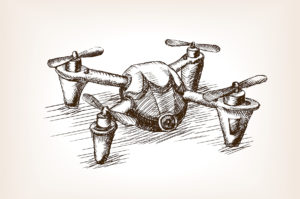2020 has undoubtedly seen mass innovation in the technology sector and new applications of drones. Here we take a look at the growth of the market and key trends of the Australian Drone Industry in 2020.
Industry Overview
The drone industry is predominantly broken into commercial and customer segments. In 2018 the commercial drones segment accounted for 59.1% of the global market’s overall value, with the customer segment accounting for the remaining 40.9%. Australia is well placed to witness the continued growth and innovation within these segments, as the Asia-pacific accounted for 34.5% of the global drones market value in 2018. Whilst there is no way to know exactly how many drones are in operation in Australia, the Civil Aviation Safety Authority (CASA) estimates the number may well be over one million.
Emerging Trends
As we look at what 2020 has brought us thus far, we are all also excited to see what the future will continue to bring. Here are just a few key trends we’ve noticed already:
Drones in Enterprise
Spanning across insurance, infrastructure, agriculture and media and telecommunications we’ve seen significant advancements in the way drones can be utilised by a variety of industries for their operations. Current uses in the agricultural industry include surveys that can gather information such as crop conditions to help farmers boost crop yields, seed sowing, fertiliser distribution and even irrigation management. In fact, recent estimates suggest that using drone technology to spray fertiliser is 40-60 times faster than spraying by hand. Looking to the future, Josh Voelker, PrecisionHawk manager for Australia and New Zealand Operations predicts that 80% of all drone usage globally will be in agriculture.
Service Market Development
As drone technology becomes increasingly user friendly and accessible, it is unsurprising their uses are expanding outside of commercial operations and instead have created their own service sector. Aerial photography and drone videos have found applications across a variety of industries – from real estate all the way to oil and gas. It comes as no surprise then that these services continue to be highly desirable, especially after the global pandemic hit and many countries went into lockdown with no way to complete their work onsite.
COVID-19
Speaking of the COVID-19 restrictions, we saw the use of drones expand significantly this year as businesses struggled to adjust to new COVID-19 lockdown rules and regulations. Precision Autonomy’s CEO Mark Halverson said, “It is a simple fact that ‘machines are immune’ to COVID-19 and have been deployed in new and exciting ways to help manage the crisis”.
Back in May the Victorian Police confirmed they were using drones to monitor public areas such as beaches to gauge the number of people in public areas and to assess if social distancing orders were being followed. Although not equipped with facial recognition technology, the drone footage was captured and then sent through to a command truck where police could review it. From there, they had the ability to send it through to the state control centre.
We saw the effects of this not just nationally, but globally as well. During the pandemic drones were utilised for medical deliveries, surveillance and modified business operations. In April this year the US Federal Aviation Administration (FAA) granted the first coronavirus-related waiver for drone flight. This enabled an oil and gas company in Houston, Texas to use an unmanned aircraft instead of humans to inspect its facilities whilst staff were confined in lockdown. The drone was utilised to inspect infrastructure and was allowed to fly beyond the pilots’ line of sight (which is usually banned by the FAA).
Conclusion
As we’re passing the halfway mark for the year it’s been an interesting few months watching the drone industry grow and find new applications. We look forward to seeing what will come next for the rest of 2020 and beyond.
REFERENCES:
https://www.thechronicle.com.au/news/farmfest-why-drones-are-future-agriculture/3186587/
https://www.legislation.gov.au/Details/F2019L01027/Explanatory%20Statement/Text
https://www.businessinsider.com/drone-industry-analysis-market-trends-growth-forecasts?r=AU&IR=T
https://www.dronefly.com/drones-in-the-field-infographic-agriculture-drones
https://www.ft.com/content/548e1735-74fa-44ff-b55e-54af1d2d9d53



